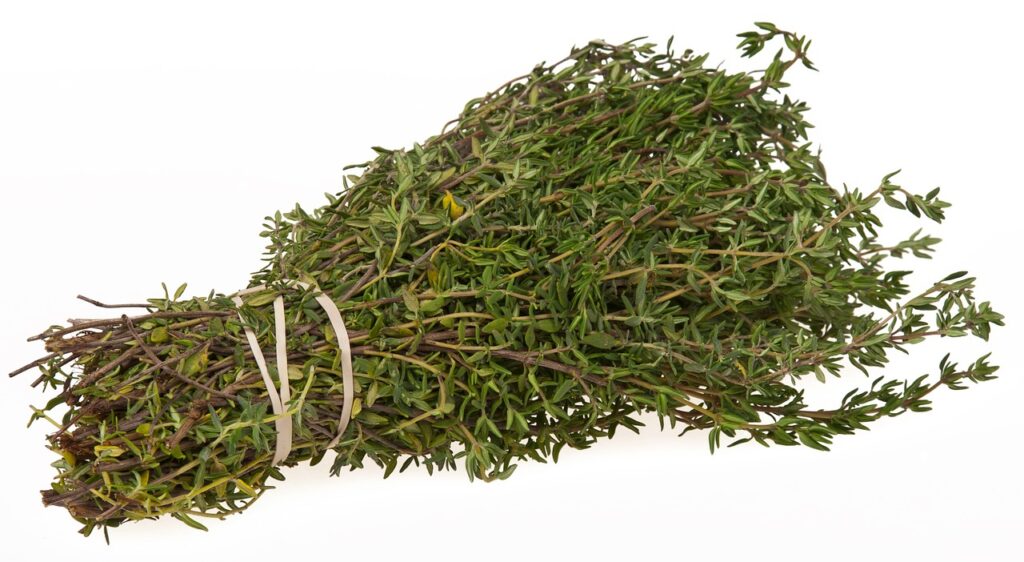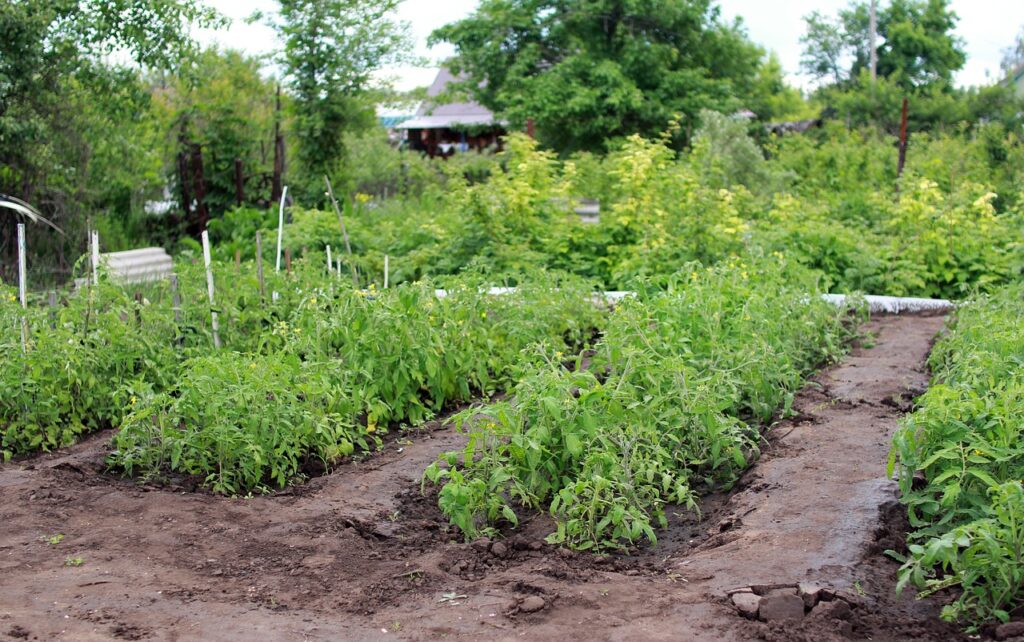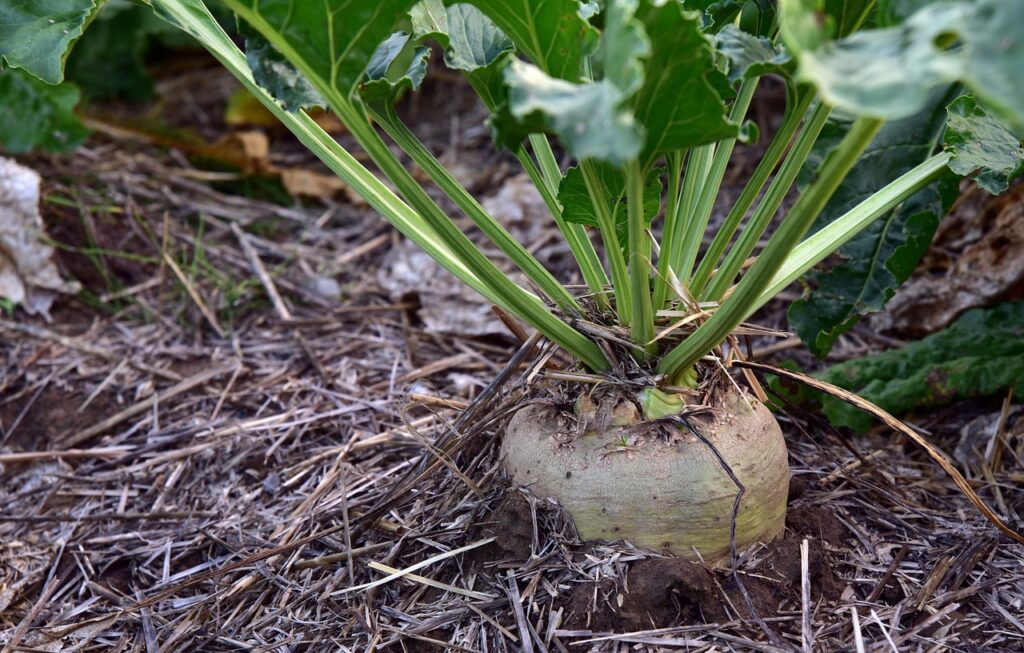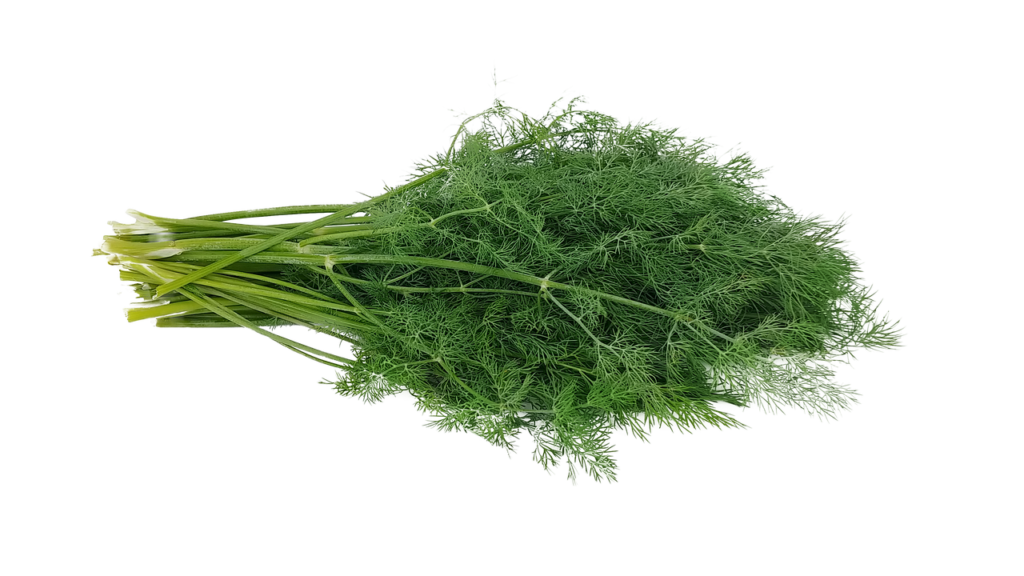As gardener, you are always looking for ways to improve your garden and increase yields. One of the best ways to increase yields and prevent pest and disease is through companion planting. In short this is the practice of planting certain plants together to improve growth and discourage pests. Thyme is a versatile herb that not only tastes great but also has many benefits when used as a companion plant. In this article, we will discuss the best planting combinations, thyme companion planting, the benefits of thyme in the garden, and watering and feeding practices for thyme. Knowing what herbs grow together will reward you for years.

As an Amazon and ebay Affiliate we may earn a commission off any purchases made through our links. This won’t affect the price you pay.
Companion planting is all about finding plants that thrive together. Here are some of the best planting combinations (similar growing conditions) for thyme companion plants:
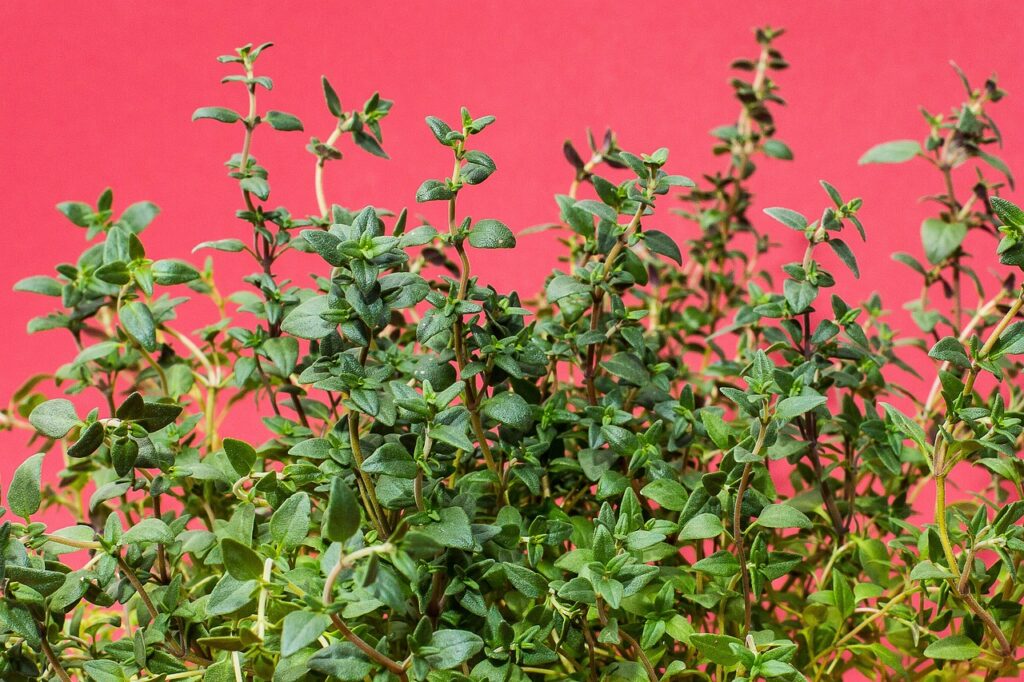
– Tomatoes: Thyme repels whiteflies and aphids, which are common pests for tomato plants. Plant thyme around your tomato plants to keep them healthy and pest-free.
– Cabbage: Thyme can attract pollinators like bees and butterflies to your garden. Plant it alongside cabbage to help with pollination and improve yields.
– Carrots: Thyme can also attract beneficial insects like ladybugs and hoverflies, which prey on pests that damage carrot plants. Plant thyme around your carrot patch to keep them pest-free.
– Peppers: Thyme is also a natural fungicide and can help prevent fungal diseases on pepper plants. Plant thyme around your pepper plants to protect them from diseases.
– Rosemary: Can rosemary and thyme be planted together? Like thyme, rosemary is a sun-loving herb that requires well-drained soil. Their compatibility in terms of growing conditions makes them ideal companions. In addition to being culinary herbs, both thyme and rosemary have aromatic leaves that naturally repel pests.
– Oregano: Oregano is another herb that has similar growing requirements to thyme. It prefers full sun and well-drained soil. Planting thyme and oregano together can not only create a visually appealing herb garden but also provide a variety of flavors for your culinary creations.
– Sage: Sage is a popular herb known for its culinary uses and distinctive flavor. It thrives in full sun and well-drained soil, making it a suitable companion for thyme. Both herbs have aromatic leaves and can attract beneficial insects like bees to the garden.
– Lavender: Lavender is a beautiful flowering herb that enjoys the same growing conditions as thyme. They both flourish in full sun and well-drained soil. This combination can create a visually stunning garden while also attracting pollinators like bees and butterflies.
When planting these herbs and vegetables together with thyme, it’s important to consider the spacing requirements of each plant to ensure they have enough room to grow and access sunlight and nutrients. Providing adequate spacing will also help prevent overcrowding and improve air circulation, reducing the risk of diseases.
Growing Thyme – The Basics
Thyme is a hardy perennial herb that is easy to grow. Here are some tips for growing thyme as a companion plant:
- Always pick a sunny spot: Thyme thrives in full sun and well-drained soil. Make sure your chosen spot gets, at least, six hours of direct sunlight per day.
- Plant thyme in the spring: Thyme is best planted in the spring, once the soil has warmed up.
- Space thyme plants 6-12 inches apart: Thyme can grow up to a foot tall and wide, so plant them at least 6-12 inches apart to give them room to grow.
- Water regularly: Thyme needs regular watering to establish itself, but make sure not to overwater it. When the soil feels dry, you know it’s time to water.
- Fertilize sparingly: Thyme doesn’t need much fertilizer, as it prefers lean soil. Use a light application of a balanced fertilizer in the spring. (Discussed in more detail below)

Benefits of Thyme in the Garden
Thyme has many benefits when used as a companion plant.
Repels pests: Thyme is a natural insect repellent and can help keep pests like whiteflies, aphids, and cabbage worms away from your garden.
Attracts beneficial insects: Thyme can also attract beneficial insects like bees, butterflies, ladybugs, and hoverflies to your garden. These insects prey on pests that can damage your plants.
Improves soil: Thyme has a shallow root system that can help improve soil structure and prevent erosion.
Adds flavor: Thyme is a delicious herb that can be used in a variety of dishes. Having fresh thyme on hand in your garden is a great way to add flavor to your meals.
Thyme and Honey Bees
Thyme plants and honey bees share a mutually beneficial relationship that makes thyme an excellent addition to any garden aiming to attract pollinators. Bees are attracted to the delicate blooms of thyme, which not only enhances the visual appeal of the garden but also encourages pollination and ensures the continued production of fruits and vegetables. Thyme is drought tolerant and is thought to help protect bees from diseases too.
Thyme is known to possess certain properties that help in attracting honey bees. Its delightful fragrance and nectar-rich flowers act as natural beacons for these vital pollinators. By planting thyme in your garden, you can provide a valuable food source for honey bees, ensuring their survival and aiding in the pollination of nearby plants.
When it comes to gardening tips, it’s important to consider thyme’s growing requirements. Thyme plants thrive in conditions similar to those preferred by honey bees. They both prefer full sun, making thyme an ideal choice for gardens that receive ample sunlight. In terms of soil, thyme is drought-tolerant and can grow well in a variety of soil types, including sandy or rocky soils. It’s important to ensure good drainage, as thyme does not thrive in overly moist soil. Providing these conditions will not only benefit the thyme but also attract honey bees in search of these favored environments.
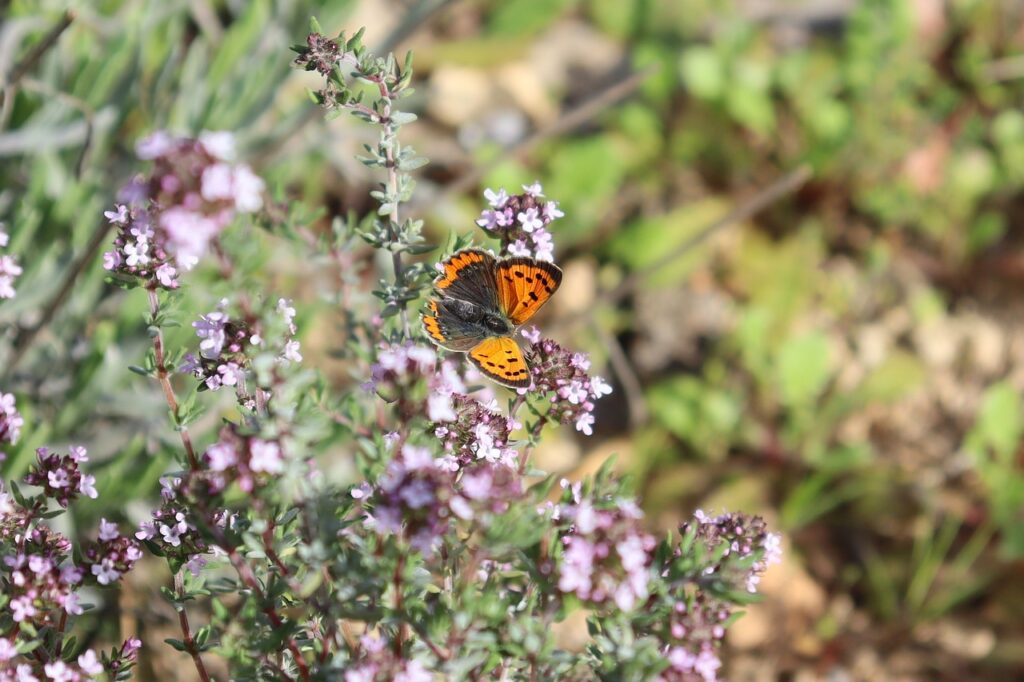
In addition to attracting honey bees, thyme itself benefits from their presence. Honey bees, while collecting nectar, inadvertently aid in pollinating the thyme plants, leading to increased productivity and a healthier plant population. This symbiotic relationship ensures the continued growth and flowering of the thyme, providing bees with an ongoing food source.
Another interesting aspect of thyme is its ability to repel certain pests. Lemon thyme, in particular, has natural repellent properties that can deter pests like mosquitoes and whiteflies. This characteristic is especially useful for those gardening organically or wishing to reduce dependency on chemical insecticides. By incorporating lemon thyme into your garden, you can create a naturally pest-resistant environment while simultaneously attracting honey bees.
Watering – in depth
As mentioned, thyme doesn’t like to be overwatered, so it’s important to water it carefully. Here are some tips to get watering right:
- Water deeply: When you water thyme, make sure to water deeply to encourage deep roots. This will help thyme plants withstand periods of drought.
- Don’t overwater: Thyme doesn’t like to sit in wet soil, so make sure not to overwater it. Water only when the soil is feeling dry.
- Mulch around thyme plants: Mulching around thyme plants can help retain moisture in the soil and prevent weeds.

Feeding
To get the best out of your thyme plants and ensure healthy growth, it’s essential to provide them with the right nutrients. Fertilizers can play a crucial role in boosting the overall health and productivity of thyme plants. Here are some options for fertilizers that can help you maximize the potential of your thyme plants.
One popular choice for fertilizing thyme is organic compost. Compost is rich in organic matter, beneficial microorganisms, and essential nutrients that promote soil fertility. Adding compost to the soil before planting thyme or top-dressing around existing plants provides a slow-release source of nutrients, improving soil structure and moisture retention.
Another effective organic fertilizer for thyme is well-rotted manure. Manure, such as cow or horse manure, is high in nitrogen, phosphorus, and potassium, which are vital for plant growth. It can be applied as a top dressing or mixed into the soil before planting. However, it’s important to ensure that the manure is well-aged and properly composted to prevent the risk of burning the plants.
For those preferring commercially available fertilizers, a balanced, slow-release organic fertilizer can be a good option. Look for a fertilizer with equal ratios of nitrogen (N), phosphorous (P), and potassium (K), such as a 10-10-10 formulation. This balanced blend provides the necessary nutrients for overall plant health, flower production, and resistance to diseases.
When it comes to applying fertilizers to thyme plants, moderation is key. Thyme is a relatively low-maintenance herb that doesn’t require excessive feeding. Overfertilization can lead to excessive vegetative growth and reduce the flavor intensity of the leaves. It’s recommended to apply fertilizers sparingly, following the package instructions, and to avoid applying them during the flowering period to preserve the aromatic qualities of the plant.
To recap:
- Use a light application of a balanced fertilizer in the spring: Thyme doesn’t need much fertilizer, but a light application of a balanced fertilizer in the spring can help give it a boost.
- Avoid over-fertilizing: Over-fertilizing can lead to leggy growth and reduced flavor in thyme plants. Stick to a light application in the spring and only fertilize if needed.
Thyme Companion Planting Tips
Here are some additional tips for planting thyme as a companion plant:
- Plant thyme around the borders of your garden to create a natural barrier against pests and promote pollination.
- Plant thyme in containers on your patio or balcony to attract pollinators and add flavor to your meals.
- Harvest thyme regularly to encourage bushy growth and prevent leggy growth.
Common Problems with Thyme
While thyme grows fairly easily, there are a few common problems to watch out for:
One common issue with thyme plants is overwatering. Thyme prefers well-drained soil, and excessive water can lead to root rot and poor growth. It’s important to allow the soil to dry out between waterings, as constantly damp conditions can suffocate the roots and promote the growth of disease-causing fungi.
Another problem that thyme plants often face is poor air circulation. Overcrowding of plants, especially in humid climates, can create a favorable environment for fungal diseases such as powdery mildew. To prevent this, ensure that thyme plants are properly spaced, allowing air to circulate freely around them.
Thyme plants are also susceptible to attacks from pests such as aphids, spider mites, and mealybugs. These tiny insects can cause damage to the leaves, weaken the plant, and spread diseases. Regular inspection of the plants and the use of natural and organic pest control methods, such as introducing beneficial insects or using neem oil, can help keep these pests at bay.
Another challenge that thyme plants face is winter hardiness. While thyme is a hardy perennial herb, certain varieties can be more sensitive to extreme cold temperatures. In colder climates, it’s advisable to cover thyme plants with a layer of mulch to protect them from freezing temperatures and frost. In regions with harsh winters, it may be necessary to grow thyme as an annual or bring potted plants indoors during the cold season.
Thyme can be susceptible to powdery mildew, especially in humid conditions. To prevent powdery mildew, make sure to water thyme at the base of the plant and avoid overhead watering.
Nutrient deficiencies can also affect thyme plants. Like other herbs, thyme requires good soil fertility to thrive. A lack of essential nutrients such as nitrogen, phosphorus, and potassium can lead to stunted growth, yellowing leaves, and poor flavor. Regularly fertilizing thyme plants with organic fertilizers or compost can help provide the necessary nutrients for healthy growth.
Storing and Drying Thyme
First and foremost, when it comes to storing your fresh thyme, a little TLC goes a long way. Start by removing any moist or wilted leaves, because nobody likes a soggy herb! Then, gently wrap the thyme in a damp paper towel to maintain just the right amount of moisture. Think of it as giving your herb a cozy little blanket for its journey into the fridge. Feeling fancy? Go ahead and place the wrapped thyme in a resealable plastic bag for extra freshness protection. And remember, avoid storing it near strong-smelling ingredients, unless you want a thyme-infused garlic kind of situation.
Now, let’s talk about the art of drying thyme. Picture this: you’ve got an abundance of fresh thyme, the sunlight is pouring in through your kitchen window, but you know time is against you. Fear not for we have drying techniques up our culinary sleeve! The easiest method is air drying, and it’s as simple as it sounds. Just tie a bunch of thyme upside down, like a little herb bouquet, and hang it in a well-ventilated area away from direct sunlight. Pro tip: choose a discreet location, or your countertop might start to resemble an herb salon!
But let’s face it, not all of us have the patience of a Zen master. If you’re in a hurry to get your dried thyme try oven drying. Preheat your oven to a low temperature, around 100°C (220°F). Place your thyme sprigs on a baking sheet lined with parchment paper, and let them bask in the gentle heat of the oven for about 1 to 2 hours. Keep an eye on those little dry beauties, though, because we don’t want them to end up as charcoal! Trust me, I’ve had my fair share of “Oops, I left it in too long” moments, and they’re not pretty.
Now that your thyme is beautifully dried, it’s time for the final act: storing it like a culinary wizard. Crumble the dried leaves into airtight spice containers, and find them a cool, dark spot in your kitchen, just like a herbular Batcave. And here’s a little secret that’ll keep your thyme flavors at their peak: don’t start breaking, crumbling, or grinding the leaves until you’re ready to sprinkle that herbaceous goodness onto your dishes. Lock in the flavor until you unleash it upon your culinary creations – think of it as telegraphing your intentions to your taste buds.

Using Thyme In The Kitchen
Thyme is a versatile herb that adds a unique and aromatic flavor to a variety of dishes. Known for its earthy and slightly floral taste, thyme is a staple in many cuisines around the world. Whether used fresh or dried, thyme can enhance the flavors of meats, vegetables, soups, stews, and even baked goods. Here are some tips on how to use thyme when cooking to elevate your culinary creations.
Fresh vs. Dried Thyme
Both fresh and dried thyme can be used in cooking, but it’s important to note that they have slightly different flavors. Fresh thyme tends to have a milder and more vibrant taste, while dried thyme has a more concentrated flavor. As a general rule, use three times the amount of fresh thyme when substituting for dried thyme. For example, if a recipe calls for 1 teaspoon of dried thyme, use 3 teaspoons of fresh thyme.
Infusing Flavors
Thyme can impart a delightful flavor when infused into oils, vinegars, or stocks. To infuse thyme into oil, heat the oil gently in a saucepan and add sprigs of fresh thyme. Let it simmer for a few minutes to release the flavor. Remove the thyme before using the infused oil in dressings, marinades, or for cooking purposes. Similarly, you can add fresh thyme sprigs to vinegar or stock and let it infuse for a while to enhance the liquid’s taste.
Roasting Meats and Vegetables
Thyme goes well with roasted meats and vegetables. Toss vegetables, such as potatoes, carrots, or bell peppers, with a drizzle of olive oil, a sprinkle of salt, and fresh thyme leaves. Roast them in the oven until tender. For meats like chicken, beef, or lamb, season them with a mixture of garlic, thyme, salt, and pepper before roasting. The flavors of thyme will infuse into the dish, creating a delicious and savory result.
Soups and Stews
Thyme is a fantastic herb to enhance the flavors of soups and stews. Add a few sprigs of fresh thyme while simmering the broth to infuse it with aromatic flavors. Discard the thyme sprigs before serving. Thyme pairs particularly well with hearty dishes, such as chicken noodle soup, beef stew, or vegetable soup.
Herbed Butter and Sauces
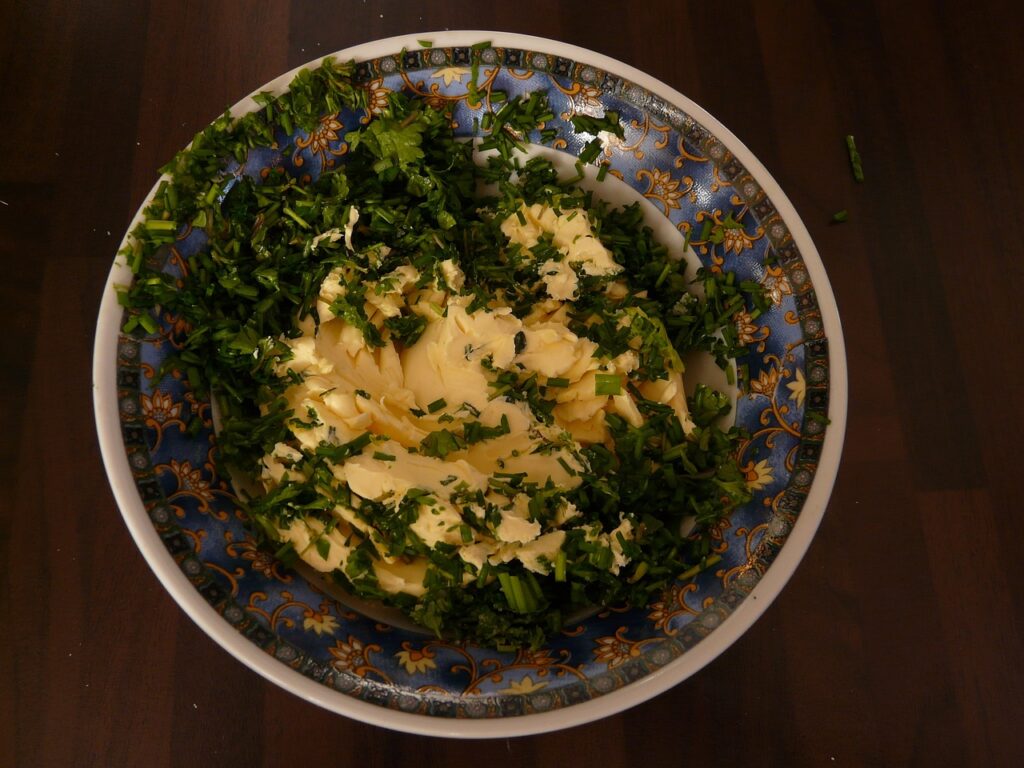
Create a flavorful herbed butter by combining softened butter with minced fresh thyme leaves and a pinch of salt. Mix well and let it refrigerate until firm. Use this herb-infused butter to top grilled steaks, spread on warm bread, or melt on roasted vegetables. Additionally, you can incorporate thyme into sauces like tomato sauce, marinara, or creamy white sauces for added depth of flavor.
Baked Goods
Thyme can add a unique twist to baked goods, especially savory bread and biscuits. Incorporate chopped fresh thyme into doughs for focaccia, dinner rolls, or herb-flavored bread. Its slightly floral notes can give an interesting flavor dimension to typically plain bread.
Infusing Spirits
Thyme’s aromatic profile also lends itself well to infused spirits. Add a few sprigs of fresh thyme to a bottle of vodka or gin and let it infuse for a few weeks. The thyme-infused spirits can be used to create unique cocktails or simply enjoyed on their own.
When using thyme in your cooking, remember to start with smaller amounts and gradually increase to suit your taste preferences. Thyme can be a potent herb, and its flavor can intensify with cooking. Experiment with different dishes and explore the versatility of thyme to elevate your favorite recipes.
Thyme Companion Plants: Final Thoughts
Thyme is a versatile and beneficial herb to grow as a companion plant. Whether you are planting it alongside tomatoes, cabbage, carrots, or peppers, thyme can help keep pests away and improve yields. By following these tips on planting, growing, and caring for thyme companion plants, you will have a healthy and productive garden.
Section 10: Thyme Companion Plants: Frequently Asked Questions
Q: Can I plant thyme in the same container as other plants?
A: Yes, thyme can be planted in the same container as other plants as long as they have similar growing requirements.
Q: Can I use thyme as a ground cover?
A: Yes, thyme makes an excellent ground cover in sunny areas with well-drained soil.
Q: Can thyme be grown indoors?
A: Yes, thyme can be grown indoors in a sunny location with good air circulation.
Thyme is a versatile and beneficial herb to grow as a companion plant. Knowing the best companion plants for thyme will help you improve yields and keep pests away. For a rounded herb garden, consider planting rosemary, oregano and any herbs you cook with regularly.
Learn more about companion planting Here
As an Amazon and ebay Affiliate we may earn a commission off any purchases made through our links. This won’t affect the price you pay.
